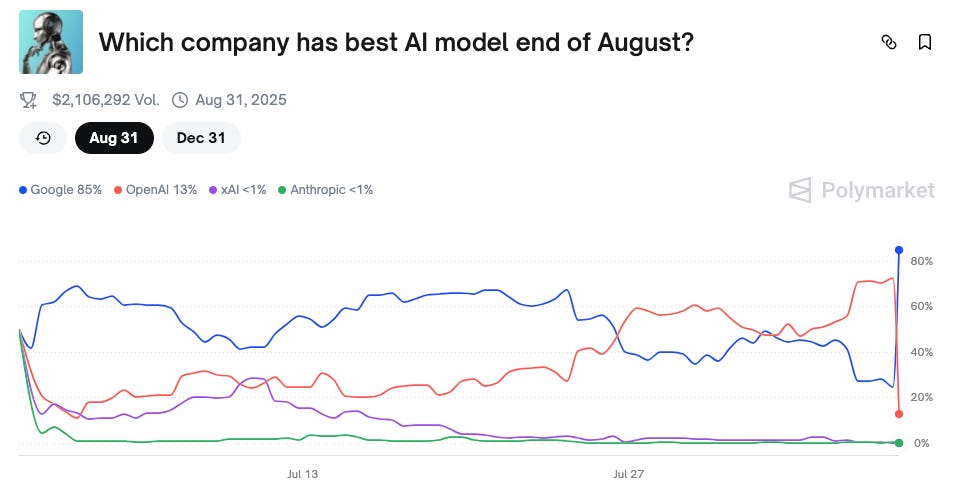Weekly Dose of Optimism #156
Standard Nuclear, GPT-5, Genie 3, Eleven Music, Lithium Orotate
Hi friends 👋 ,
Happy Friday and welcome back to our 156th Weekly Dose of Optimism. This one practically wrote itself: DOE is making big nuclear moves, OpenAI and Google dropped new models, ElevenLabs is taking their tech to music, and researchers may have found a simple Alzheimer’s therapeutic. The Optimism Gods lobbed me a softball this week. Hopefully we knocked it out of the park.
Let’s get to it.
Today’s Weekly Dose is brought to you by… Stripe Startups
Every venture-backed company — you, yes, you — should work with Stripe Startups.
Stripe’s mission is to increase the GDP of the internet, and it’s working. Last year, 1.3% of global GDP flowed through Stripe, over $1.4 trillion and growing. 78% of the Forbes AI 50 use Stripe’s financial infrastructure to monetize faster, experiment with pricing, and grow revenue.
Startups need to monetize faster, experiment with pricing, and grow revenue, too, so that they can become big companies faster and grow the GDP of the internet. That’s why Stripe launched Stripe Startups.
Stripe Startups is the company’s new program designed to support early-stage, venture-backed businesses as they build, iterate, and scale. Founders enrolled in Stripe Startups get access to credits to offset Stripe fees, expert insights, and a focused community of other founders building on Stripe.
You’re going to use Stripe anyway. Get the white-glove experience.
(1) Energy Department Announces First Pilot Project for Advanced Nuclear Fuel Lines
From the U.S. Department of Energy
DOE has conditionally selected Standard Nuclear as the first U.S. company accepted into the recently announced fuel line pilot program, announced in July 2025.
The DOE selected Standard Nuclear, a Not Boring Capital portfolio company, to lead the first pilot project under its new nuclear fuel line program. The initiative, backed by a 2025 Trump EO, will reduce reliance on foreign enriched uranium and support the deployment of high-efficiency reactors by mid-2026. Standard Nuclear will develop fabrication facilities in Tennessee and Idaho to produce TRISO fuel, while sourcing uranium through the DOE’s HALEU program.
TRISO fuel is made of uranium particles individually coated with multiple layers of carbon and ceramic, creating a robust, heat- and radiation-resistant structure. It’s designed to be inherently safer than conventional fuel, capable of withstanding extreme conditions without melting or releasing radioactive material. Basically, nuclear was already extremely safe and TRISO fuel reduces the risk even more.
This announcement is big for Standard Nuclear (obviously) as it’s a really strong signal that it can effectively work with the federal government and that its approach is feasible. But it’s also big news for America. The tide has been shifting on nuclear for a few years now, but now we’re also seeing real, government action being taken and private companies win business by supporting those actions.
And speaking of enriched uranium…
This week, General Matter signed a lease with the DOE to establish the nation’s first U.S.-owned, privately developed uranium enrichment facility at the former Paducah Gaseous Diffusion Plant, where they plan to enrich uranium by the end of the decade.
Enrichment is upstream of TRISO fabrication. Pull the uranium from the ground, enrich it to various (sub-weapons-grade) levels depending on the type of reactor it’s going to feed, and if it’s an advanced reactor, pack it into tiny, inherently safe TRISO pellets for use anywhere from data centers to remote communities to utilities to the moon.
These are big steps in re-establishing a nuclear fuel supply chain in America, which we once had but, like so many other now-critical industries, gave up. Before Standard Nuclear, there was no independent TRISO fabrication company (i.e. without its own reactor) in the US, and before General Matter, there was no uranium enrichment company in the US. We import most of our enriched uranium from Russia, even while sanctioning them in other areas.
For a history of how we let this happen, and what it’s going to take to bring it back, we highly recommend Mike Solana’s piece on General Matter for Pirate Wires, American Power.
(2) GPT-5 is Here
Our smartest, fastest, and most useful model yet, with thinking built in. Available to everyone.
From OpenAI
OpenAI released GPT-5 yesterday, and while the reviews from those who had early access were fairly breathless, the general sentiment seems to be that OpenAI made a bunch of product improvements and very little in the way of progress towards a digital god that replaces the need for humans altogether. That’s great news! It’s exactly what we should be rooting for: better tools for humans. Goldilocks zone, baby!
I’m no AI expert (I only play one on LinkedIn), but this feels like the shape of AI launches for a while: marginally faster, smarter, prettier, easier, and cheaper. GPT-3.5 was the once-in-a-decade magic moment: it paired a model with a UX in ChatGPT that turned AI into a mass-market phenomenon. GPT-4o spread that magic across the multimodal features consumers now expect. GPT-5 mostly made those capabilities better: more reliable, more performant, more consistent. The magic is being refined into something you can actually depend on. And that’s OK.
Something, something, Louis CK airplane wifi bit something, something. The magic is that airplane wifi even existed, even if it was unreliable, slow, and glitchy. Now it’s faster, more stable, and in some cases, thanks to companies like SpaceX, you can stream video, make calls, or work in real time from a private jet over the middle of nowhere.
Magic, improved incrementally over time, compounds into real-world, life-changing utility. And maybe, just maybe, one of these iterations will bring another leap whether that’s GPT-6, GPT-7, or something we haven’t even named yet.
(3) Genie 3: A new frontier for world models
From Google Deepmind
Today we are announcing Genie 3, a general purpose world model that can generate an unprecedented diversity of interactive environments. Given a text prompt, Genie 3 can generate dynamic worlds that you can navigate in real time at 24 frames per second, retaining consistency for a few minutes at a resolution of 720p.
Not to be outdone, Google DeepMind dropped what might be the most “magic” AI release of the week: Genie 3. It’s what they call a “world model,” an AI that can simulate entire environments, including physics, visuals, and how those worlds respond to your actions. Feed it a text prompt, and Genie 3 generates a fully interactive world you can explore in real time at 24 frames per second, with surprisingly strong consistency that lasts for minutes. I haven’t had a chance to play around with it yet, but the demo videos are extremely impressive and I am looking forward to exploring it myself this weekend.
Unlike traditional 3D engines, Genie 3 doesn’t use prebuilt assets. It generates each frame on the fly, adapting dynamically as you move or interact. You can also change the world mid-experience by prompting events like storms or new objects. The results range from photorealistic coastal walks and deep-sea dives to surreal fantasy scenes and animated characters.
I am not sure how immediately valuable this is for gaming studios or Hollywood or even hobbyists, but the ability to dynamically and realistically generate and change the virtual world around you seems like a key building block for next-gen gaming, metaverse, and whatever comes after AGI.
Long-time readers of the Dose will know that we have been long-time “Google DeepMind is way more impressive than it gets credit for” truthers. After its upgrades and OpenAI’s somewhat underwhelming GPT-5 release, predictors on Polymarket now assign an 85% chance to Google having the best AI model at the end of August. What a TRANSFORMation.
From ElevenLabs
With Eleven Music, businesses, creators, artists, and every single one of our users can generate studio-grade music from natural language prompts.
Let the music drop.
ElevenLabs, the company behind some of the most realistic text-to-speech and voice-cloning tools on the market, just launched Eleven Music. Eleven Music lets users create studio-quality songs from natural language prompts, with full control over genre, structure, and instrumentation. Users can generate everything from instrumental scores to vocal tracks in multiple languages, then fine-tune lyrics or individual sections with precision editing tools. It was trained on a dataset of studio-recorded music, vocals, and lyrics, and was developed in collaboration with artists, publishers, and music producers.
AI music isn’t a new concept, but Eleven’s take stands out for how polished and flexible the output is and, importantly, for the fact that it's cleared for nearly all commercial use cases, from advertising to film to social content to just cooking up bangers. Public access is now available. Excited to jam out to some chart-topping Eleven Music soon.
(5) Lithium deficiency and the onset of Alzheimer’s disease
Aron et al in Nature
Replacement therapy with lithium orotate, which is a Li salt with reduced amyloid binding, prevents pathological changes and memory loss in AD mouse models and ageing wild-type mice. These findings reveal physiological effects of endogenous Li in the brain and indicate that disruption of Li homeostasis may be an early event in the pathogenesis of AD. Li replacement with amyloid-evading salts is a potential approach to the prevention and treatment of AD.
We cover Alzheimer’s more than just about any other area of medical research. Partly because it runs in the family…so yes, we’re hoping science beats the clock. But also because Alzheimer’s research is some of the most dynamic and high-stakes out there. It’s got everything: big breakthroughs, public failures, weird theories, and some of the best clues we have into how the brain actually works. So when something big drops, we pay attention.
This week something big dropped: researchers discovered that lithium levels in the brain, not the bloodstream, drop early in people with mild cognitive impairment and Alzheimer’s. It’s not just a symptom, either. Lithium gets pulled into amyloid plaques, the hallmark gunk of Alzheimer’s, which keeps it from doing its job. When researchers fed mice a lithium-deficient diet, things got worse fast: more plaques, more tangled proteins, more inflammation, and faster cognitive decline.
Then they flipped the script. The team gave mice lithium orotate, a low-dose, brain-accessible form that avoids plaque traps, and saw major improvements. Less plaque, fewer tangles, preserved synapses and memory. Even healthy aging mice benefited. Lithium deficiency also triggered gene activity eerily similar to what’s seen in human Alzheimer’s brains. The takeaway: lithium might play a much more important role in brain aging than anyone realized, and very low, targeted doses could become part of future prevention or treatment.
Now if only there were a gummy entrepreneur out there that could put this lithium orotate into a gummy…
Have a great weekend y’all.
Thanks to Stripe Startups for sponsoring. Love these guys, we don’t say that enough.
We’ll be back in your inbox next week.
Thanks for reading,
Packy + Dan






A functional medicine doctor put my father on lithium oratate five years ago, alongside gut interventions,
and it has done wonders for his cognitive health. I’m happy this is finally getting mainstream attention. Thanks for bringing awareness to it!
Hard to keep up with all the incredible progress being made!